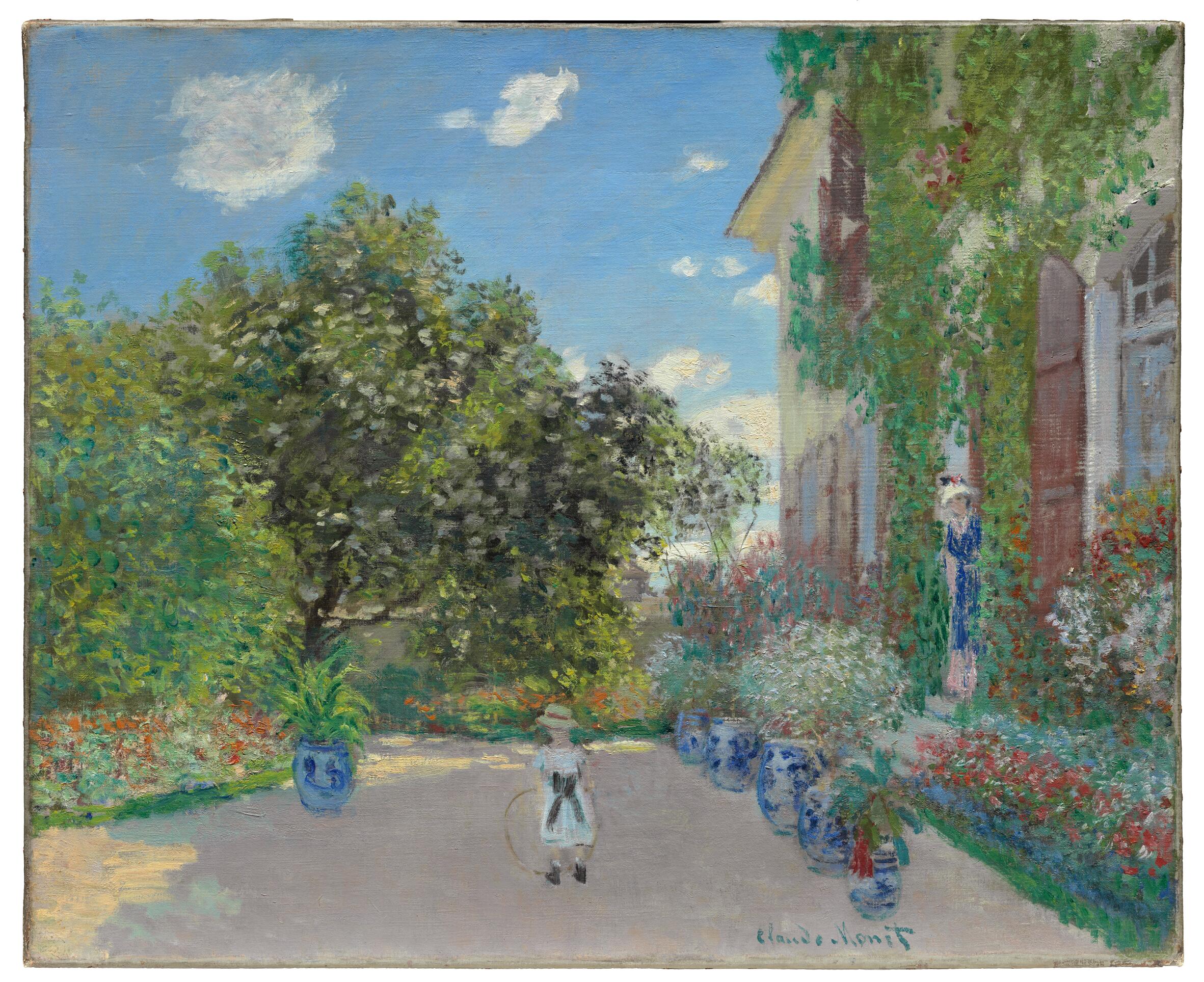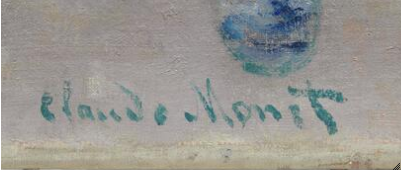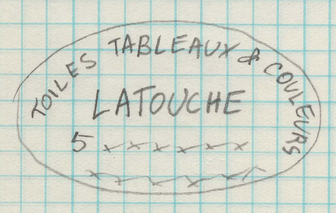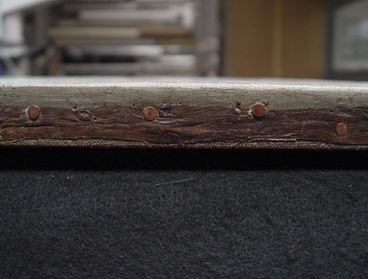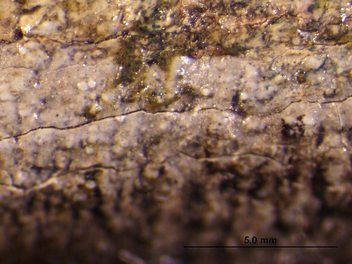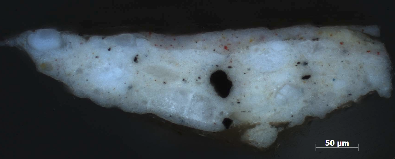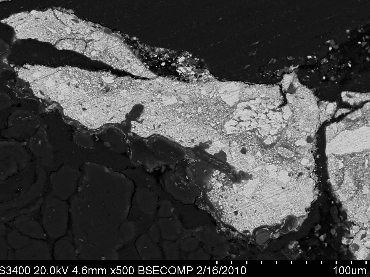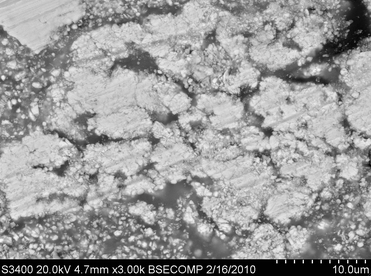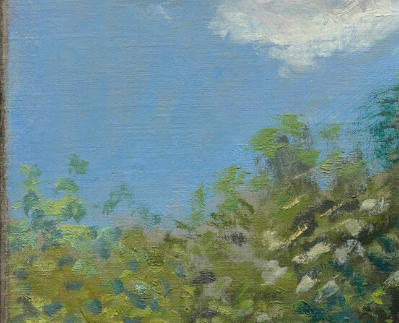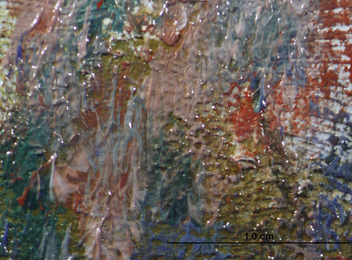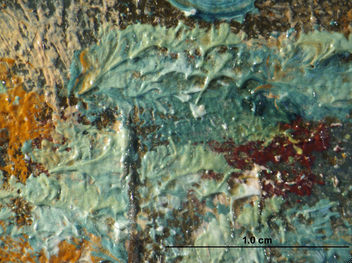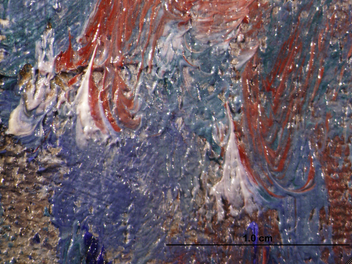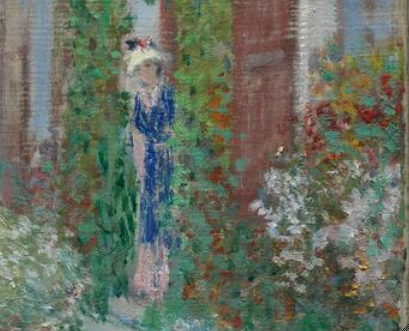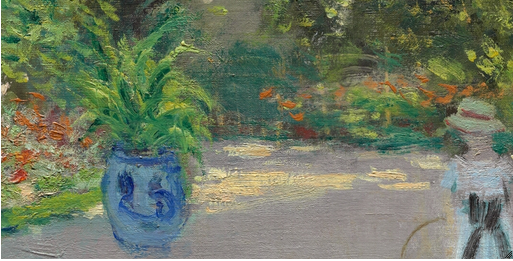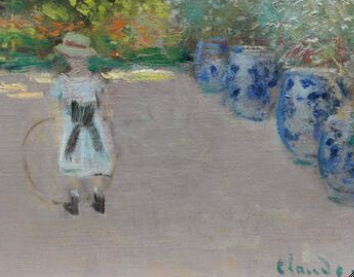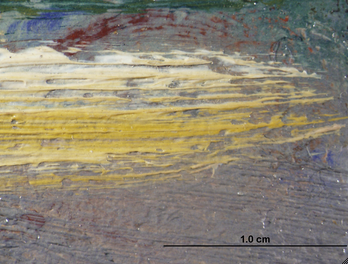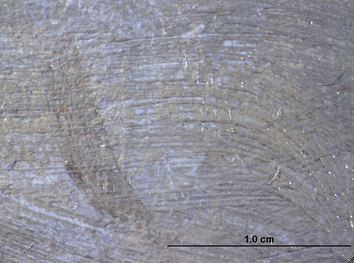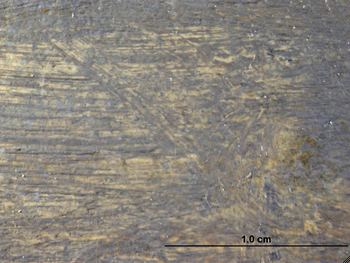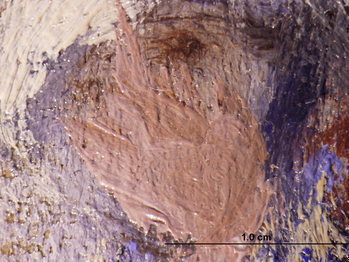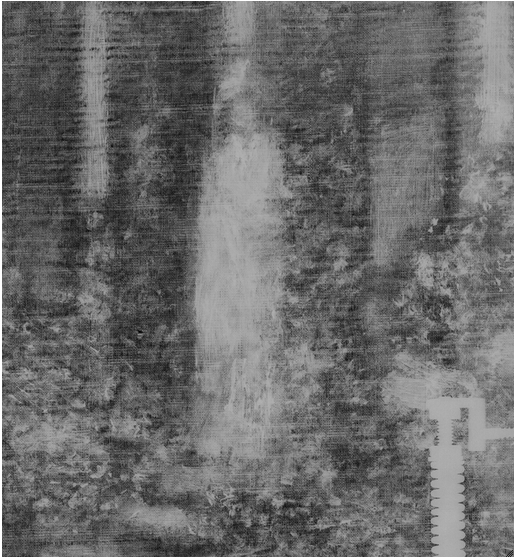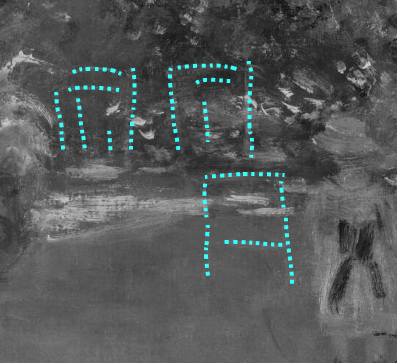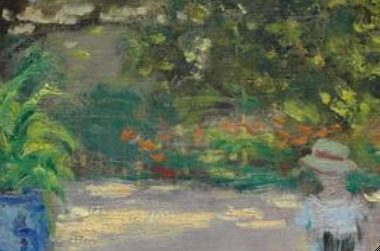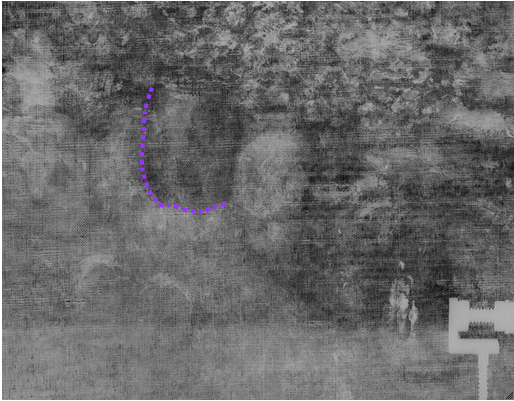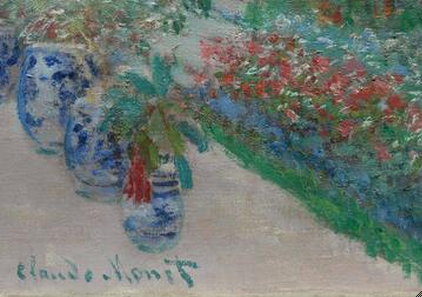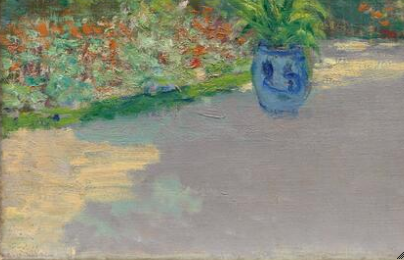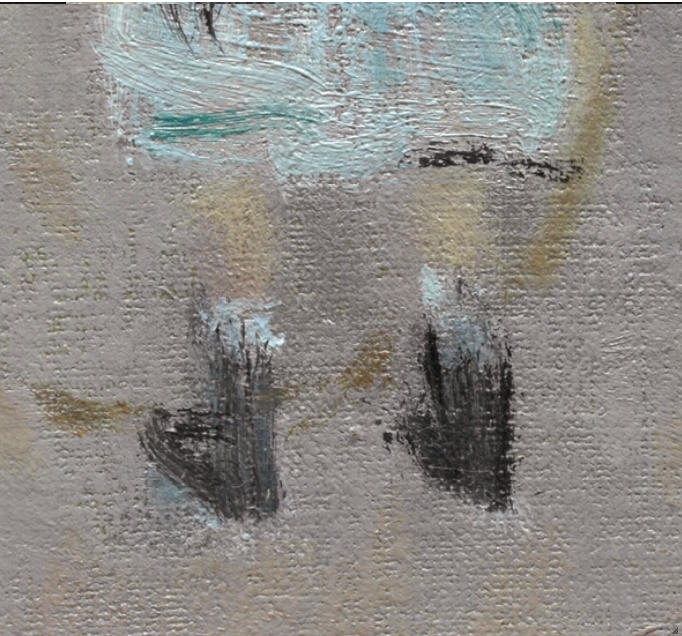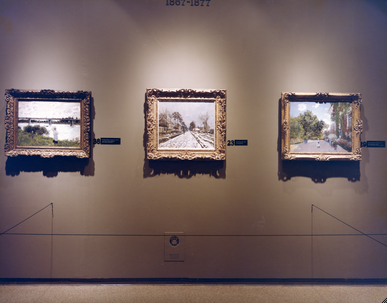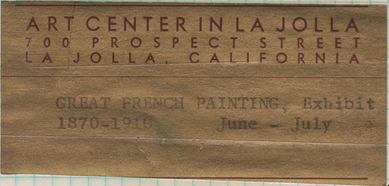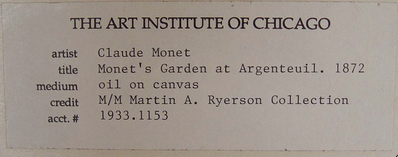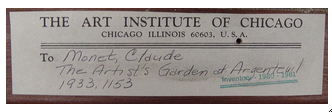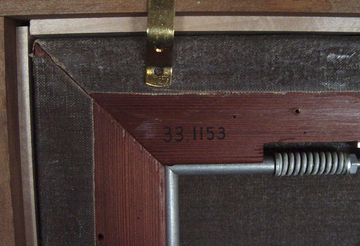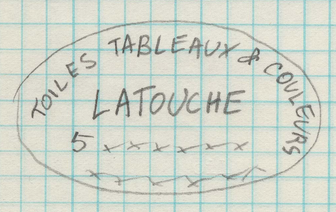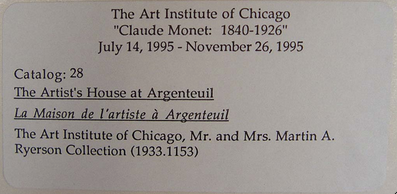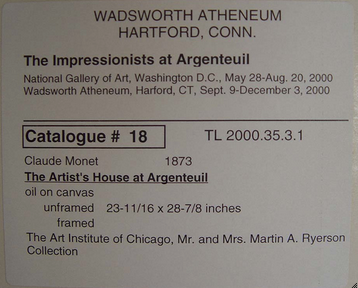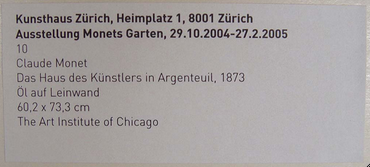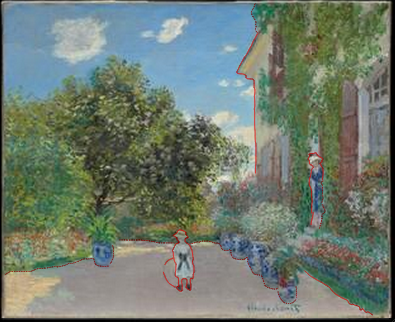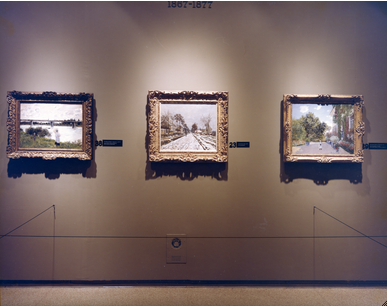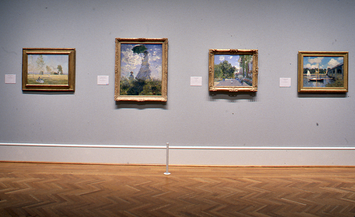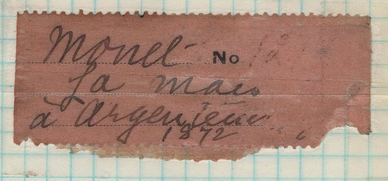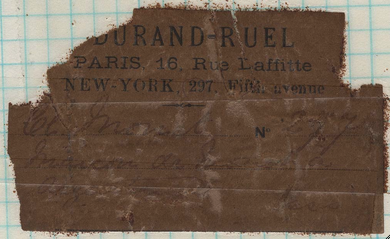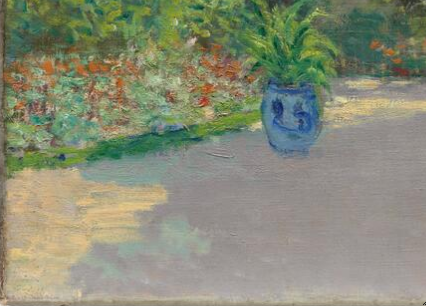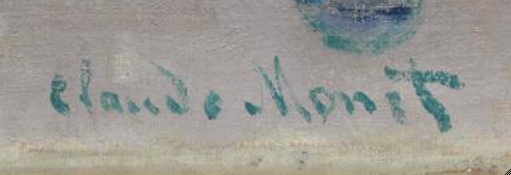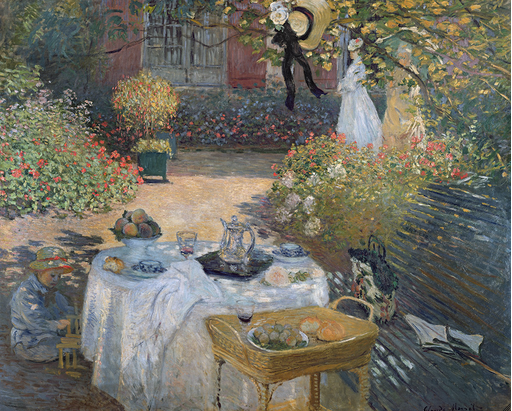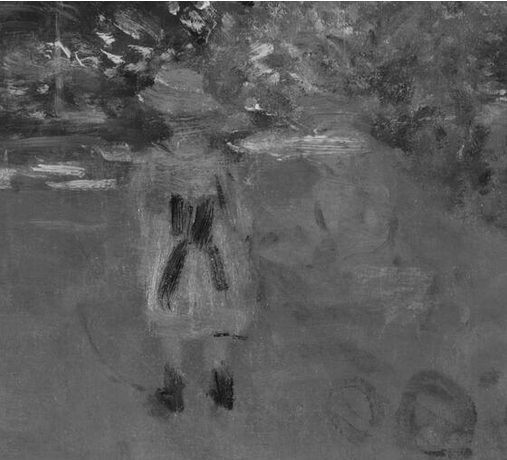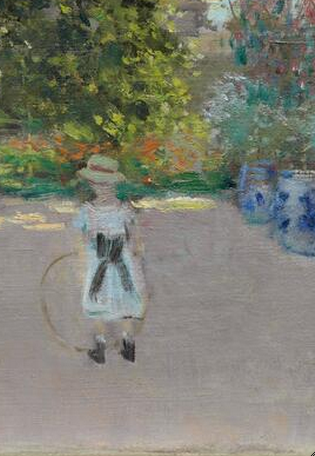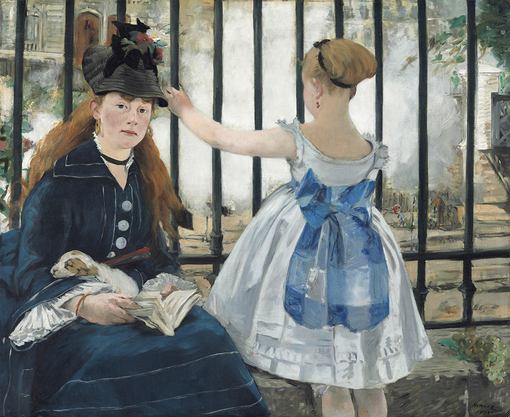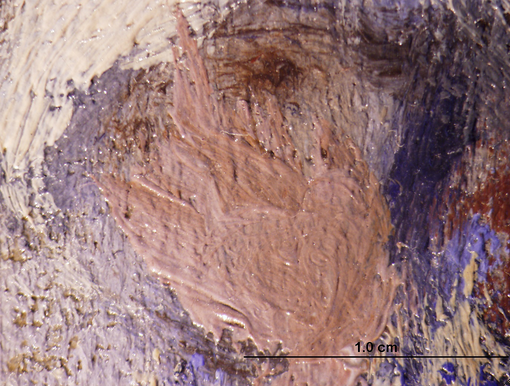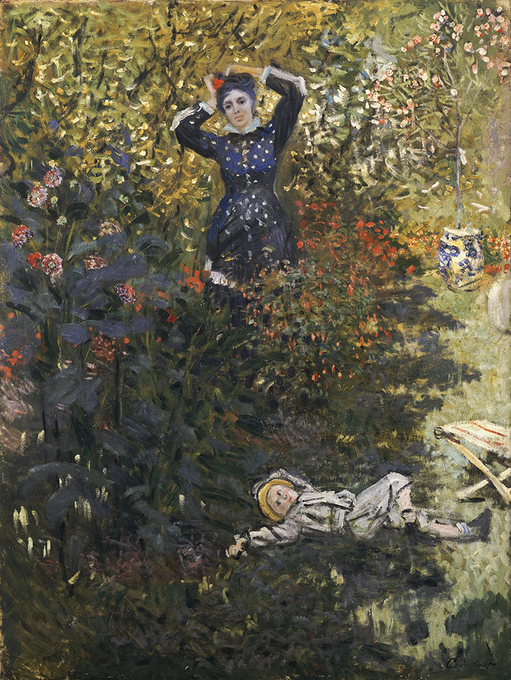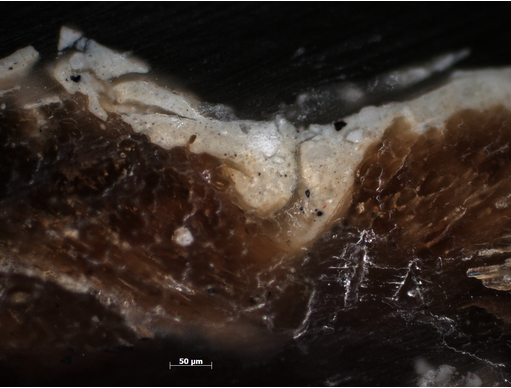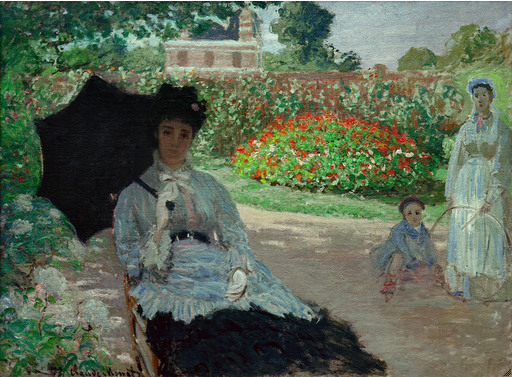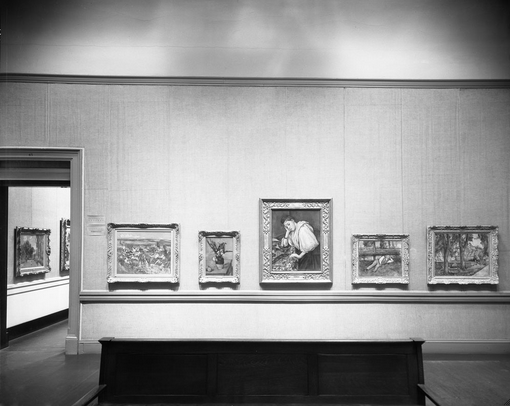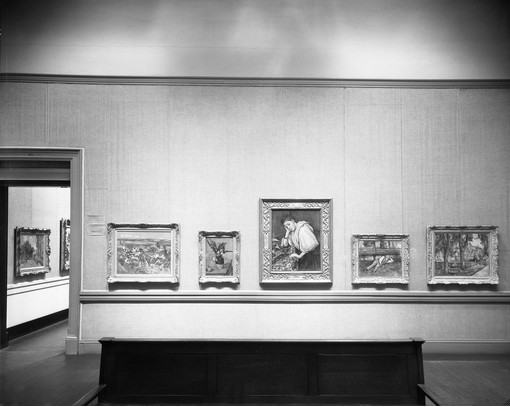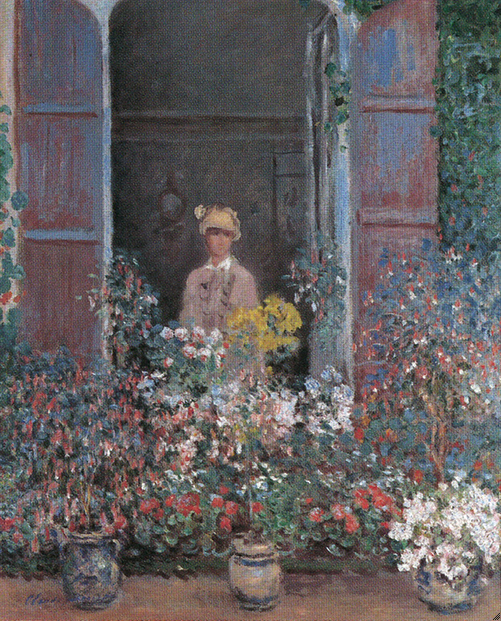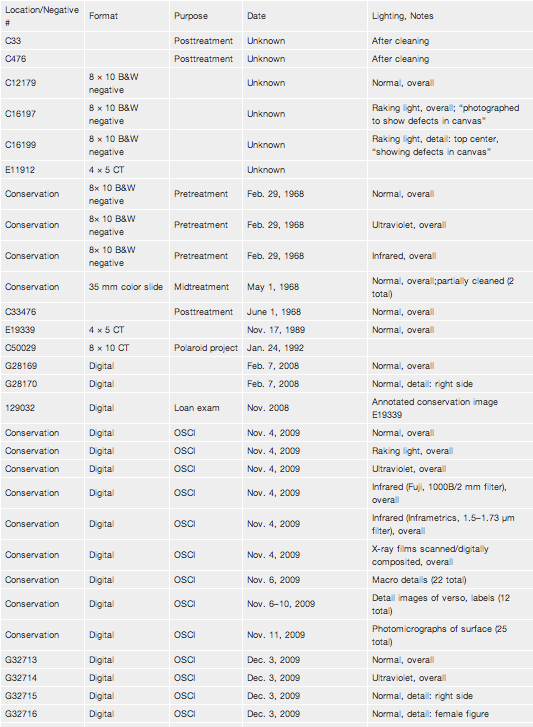Cat. 15
The Artist's House at Argenteuil
1873
Oil on canvas; 60.2 × 73.3 cm (23 11/16 × 28 7/8 in.)
Signed: Claude Monet (lower right, in bluish-green paint)
The Art Institute of Chicago, Mr. and Mrs. Martin A. Ryerson Collection, 1933.1153
Monet’s Coming-of-Age Home
During Monet’s nearly seven years at Argenteuil, the suburb where he took up residence in December 1871, he produced around 180 canvases. These coincide with his improved circumstances—from itinerancy to a settled home and a secure funding source, the result of significant purchases of his work by his dealer, Paul Durand-Ruel. Although the Monets’ comfortable existence would turn precarious again in 1874 as a result of Durand-Ruel’s own faltering finances, the dealer’s patronage made possible the rental of a spacious house and garden where Monet and his family lived from the end of 1871 until the summer of 1874. In contrast to the many canvases painted during this period, which were dominated by river views and riverside promenades, the newly built railway bridge, pleasure boats, fields, and factories, The Artist’s House at Argenteuil is one of a handful of canvases that depict his wife, whom he had married in 1870, and their child enjoying their newly established domesticity.
Foremost among the reasons for Monet’s decision to move his family from Paris to the “agréable petite ville”—as Argenteuil was described in local guidebooks—was its location, which was equally picturesque (situated along a wide expanse of the Seine) and convenient (a mere fifteen-minute train ride to the Gare Saint-Lazare, Paris). Having returned to France from Holland after his self-imposed exile during the Franco-Prussian War and Commune insurrection at the end of 1871, Monet and his family registered at the Hôtel de Londres et New York on the place du Havre, opposite the Gare Saint-Lazare and a few blocks from Monet’s rue de l’Isly studio. The house he found in Argenteuil was similarly well situated—down the street from the Argenteuil station, which facilitated the possibility of commuting to Paris to use his studio and returning home to Argenteuil in the evening.
The house had been most recently rented by the Realist painter Théophile Ribot, and it was probably recommended to Monet by Édouard Manet, who knew the owner, Mme Emilie-Jeanne Aubry, and whose family owned a property in nearby Gennevilliers. Situated at the corner of the rue Pierre Guienne and the boulevard Saint-Denis, the handsome, three-story house had a cellar (cave) and garden covering a total of 28,654 square feet. In many ways the Maison Aubry, which eventually included a staff of a gardener and two domestic servants, was Monet’s coming-of-age residence.
Despite the no doubt bustling household Monet established in Argenteuil, he rarely depicted interior domestic scenes. In Camille at the Window, Argenteuil at the Virginia Museum of Fine Arts (fig. 15.1 [W287]) we catch a glimpse of the interior of Monet’s rue Pierre Guienne home. This first home in Argenteuil was distinguished by its red shuttered façade that opened out onto a stone dust courtyard, with decorative pots and meticulously organized flower beds that line the “stage” on which the child plays with a wooden hoop in the Chicago painting. In the Virginia picture, a female figure looks out of a window from the interior, which is more implied than clearly described, onto the courtyard. The woman here, possibly a housemaid, expresses a sense of inquietude and ambivalence that is at odds with the familial harmony exuded by the composition of the Art Institute painting, in which young Jean is watched over by his mother, who stands in the open doorway.
Monet’s Image of Childhood
In The Artist’s House at Argenteuil the focal point of the composition is Jean, turned away and wearing summery garb with a wide, gray-black sash tied at the back, who stands at center. The blue-and-white-glazed flower pots are on either side of his figure. At some point Monet eliminated a pot, which was positioned next to the now single vessel to the left of Jean (fig. 15.2); this adjustment more directly aligns the boy as the main focal point within a diagonal of the decorative ceramics at lower right and the single pot at upper left (see Technical Report). In comparison to the lush vegetation of the circular flower bed, the beds around the house, and a variety of flowering plants in the large vases (which the artist could have brought back from his trip to Holland in 1871), Jean and Camille seem vaguely, almost perfunctorily, rendered. [glossary:X-ray] and [glossary:UV] examinations reveal that the artist made several important changes to the figures, especially to the child. As Mary Mathews Gedo points out, this painting had to have been executed prior to Jean’s sixth birthday on August 8, 1873, since he has not yet graduated from unisex dress to short pants. Four quick strokes of black make up the wide bow (fig. 15.3) painted over an earlier bow or sash of a greenish blue that is similar if not an exact match of that used for the signature (fig. 15.4).
The Artist’s House at Argenteuil can be compared to the contemporary depictions of Jean in a garden setting, such as Camille and Jean Monet in the Garden at Argenteuil (fig. 15.5 [W280]) and Le déjeuner: Panneau décoratif (fig. 15.6 [W285]). The Chicago view is unique in showing Jean alone, standing, and facing away from the viewer. In Le déjeuner, Jean is seated in profile, absorbed in play with wooden building blocks, while in Camille and Jean Monet in the Garden at Argenteuil he looks out toward his mother, his hand touching the wooden hoop that is steadied by the aproned house servant or nanny to his left. Infrared examination of the Art Institute’s painting shows that Jean was initially conceived as seated there, too, perhaps in a cart or on the pavement facing out, among objects that appear to be toys rather than a hoop (fig. 15.7). The infrared image also reveals that an earlier stage of the composition included the child wearing a brimmed hat. Additional forms visible in the infrared image in the area in front of the child suggests a wheeled object, similar to the small wheelbarrow or push-cart toy in the foreground of another child-in-garden composition, painted seven years later (fig. 15.8 [W685]). In this familial scene, Monet’s second son (Michel, b. 1878) stands on a garden path, flanked by similarly styled decorative pots.
The changes made to Jean's position in an earlier stage of composition suggest that Monet had an analogous seated pose in mind that he abandoned. The changes are evident on the final surface, through which one can detect bits of flesh-tone pigments in the area where the boy’s face would have been positioned, as well as evidence of the pale blue used for the torso, a similar shade, moreover, to that used for the figure of the seated child in the other two paintings (see fig. 15.5 and fig. 15.6). Although there are no extant drawings or sketches from which to interpret Monet’s reasons for changing the seated Jean to the standing child who turns away from the viewer (fig. 15.9), it is tempting to think that the artist had in mind Manet’s The Railway (fig. 15.10), begun in 1872, in which a neighbor’s daughter poses facing away from the viewer and wears a similar white dress bowed at the back.
Camille at Argenteuil
An ever-present figure in the house and garden views, the female figure in the doorway with deeply set eyes and dark hair fits the shorthand Monet often used for his wife. Camille’s dress, which appears to be painted so lightly as to have been breathed onto the canvas, is actually the result of a relatively dense application of pink and blue pigments over a cream-colored dress visible underneath (see Technical Report). The X-ray suggests that the woman originally wore a fuller, shapeless robe d’intérieur that had broader sleeves (fig. 15.11). Her face, now covered in pinkish flesh tones, was earlier laid in using grayish beige and included brownish daubs that may have articulated her eyes (fig. 15.12). Whereas Monet’s first idea signaled Camille, in the final composition, her features are more generalized than those with which he customarily identified her.
A Sense of Place
In contrast to other works in which the artist’s vantage point is closer to his subject (e.g., fig. 15.5), for the Chicago composition Monet repositioned himself farther back on the same stone-dust courtyard and just to the left of the house, looking toward the flowering trees that dominate other canvases depicting the garden (e.g., fig. 15.13 [W282]). Although scholars have interpreted Jean’s isolation and the smaller, retiring female in the doorway as symbolizing strain within the Monet family, there is no evidence to indicate that Monet intended his placement of Jean to suggest estrangement. And the presence of the boy’s mother seems in keeping with Jean’s age and other paintings coupling a female attendant with Jean, at the crossroads of childhood, from toddler to young boy.
The seven years Monet spent at Argenteuil were significant and prolific. For the first time in his career, he enjoyed accommodations that allowed him to entertain journalists, writers, collectors, and especially artist-friends Pierre-Auguste Renoir, Alfred Sisley, Gustave Caillebotte, Eugène Boudin, and Manet. These visits, documented by paintings and portraits, resulted also in further discussions of the artistic agenda of this like-minded group. And it is no coincidence that the homogeneity of the works painted in Argenteuil by Renoir, Caillebotte, and Manet, among others, laid the groundwork for a common cause and, ultimately, for a proposal, composed and signed in Monet’s living room on the rue Pierre Guienne, that called for a series of exhibitions that would begin in 1874.
Even though the Maison Aubry was used as a meeting place, for Monet, it was first and foremost a home with a well-cared-for garden; a kind of suburban showcase that provided a generous backdrop for new motifs and new directions. In The Artist’s House at Argenteuil, we have a rare glimpse of how the Monets lived in Argenteuil in this depiction of Monet’s son playing outside the family home. It is a picture that Monet no doubt knew would appeal to his Parisian public the ideal suburban scene, lush, light-filled, and family oriented. That he changed the pose of his son—from seated to a standing position, and from facing out to turning away—suggests that he considered even family members as pictorial elements. In the final composition, Jean’s pose, echoing the verticality of the decorative pots, offers a splash of lightness to the courtyard in shadow. Camille’s pink and blue dress animates the columns of green ivy that frame her. Monet is off stage, observing, a position mirroring the reality of his situation while at Argenteuil—as husband and father, businessman and artist-in-residence, and, as this painting makes clear, already an appreciative and avid horticulturalist.
Gloria Groom
Technical Report
Technical Summary
Claude Monet’s The Artist’s House at Argenteuil was painted on a [glossary:pre-primed], no. 20 portrait ([glossary:figure]) linen [glossary:canvas]. A stamp for the [glossary:color merchant] Latouche was present on the back of the original [glossary:stretcher] (discarded). The warm-gray-colored [glossary:ground] consists of two layers. The ground remains visible throughout the composition at breaks in the brushwork. The composition was built up from an initial [glossary:lay-in] of relatively thin layers of opaque paint. The artist made use of a variety of brushwork in the painting, including localized areas of more thickly applied, textural [glossary:wet-in-wet] application in the flowers and foliage and thinly applied strokes of opaque color applied with flat brushes used to denote, for example, the dappled sunlight on the pavement. Technical examination revealed pentimenti in the area to the right of the child. It appears that, at an earlier stage of the painting, the child was depicted facing the viewer, possibly in a seated or crouching position. Farther in the foreground of the earlier painting, there are circular forms related to an unidentified object or objects. These earlier elements were covered over with thinly applied paint that is similar to, but does not exactly match, the surrounding foreground paint, and probably due to the increased transparency of the overlying paint layers over time, the painted-out forms remain faintly visible to the unaided eye. The artist also made alterations to some of the flowerpots, including the elimination of one on the left side of the composition, and to the female figure’s form. Other more minor changes, made during the final stages of painting, are evident, such as the addition of the diagonal band of green foliage at the lower right.
Multilayer Interactive Image Viewer
The multilayer interactive image viewer is designed to facilitate the viewer’s exploration and comparison of the technical images (fig. 15.14).
Signature
Signed: Claude Monet (lower right, in bluish-green paint) (fig. 15.15). The underlying paint was dry when the signature was applied.
Structure and Technique
Support
Canvas
Flax (commonly known as linen).
Standard format
The dimensions correspond to a no. 20 portrait (figure) standard-size stretcher (73 × 60 cm), turned horizontally.
Weave
[glossary:Plain weave]. Average [glossary:thread count] (standard deviation): 22.9V (0.8) × 20.5H (0.9) threads/cm. The vertical threads were determined to correspond to the [glossary:warp] and the horizontal threads to the [glossary:weft]. No weave matches were found with other Monet paintings analyzed for this project.
Canvas characteristics
There is mild, fairly even [glossary:cusping] on the top, right, and bottom edges, with stronger cusping along the left edge.
Stretching
Current stretching: Dates to the 1968 treatment (see Conservation History). The canvas is attached with copper tacks irregularly spaced 1.5–10 cm apart.
Original stretching: Tack holes spaced 4–7 cm apart; most correspond to the cusping pattern.
Stretcher/strainer
Current stretcher: Four-membered [glossary:ICA spring stretcher]. Depth: 2.8 cm.
Original stretcher: Discarded. The pre-1968-treatment stretcher may have been the original stretcher. The 1968 treatment notes indicate that the previous stretcher was five membered with a vertical [glossary:crossbar]. Depth: Not documented. There is more fabric on the left and top [glossary:tacking edges], and a continuous fold in the canvas on those edges suggests that excess fabric was folded over the back edge of the original stretcher. If this was the case, the original stretcher depth would have been approximately 1.8 cm.
Manufacturer’s/supplier’s marks
A partially illegible, oval-shaped stamp from the color merchant Latouche was transcribed from the back of the pre-1968-treatment stretcher (discarded) (see Conservation History): TOILES TABLEAUX & COULEURS / LATOUCHE / 5 xxxxxx / xxxxxx (fig. 15.16)
Preparatory Layers
Sizing
Not determined (probably glue).
Ground application/texture
The ground extends to the edges of the top, bottom, and right [glossary:tacking margins] but stops short of the left edge (fig. 15.17). This suggests that the canvas was cut down from a larger piece of primed fabric on the top, bottom, and right sides; the left edge probably corresponds to the edge of the larger roll of canvas, which was attached to the commercial priming frame. Based on [glossary:cross-sectional analysis], the ground appears to consist of two layers; this is consistent in samples from both the tacking edge and the picture plane (fig. 15.18). In the backscattered electron ([glossary:BSE]) images, the lower layer appears richer in lead white, as evidenced by its brighter white appearance, and has a finer particle size distribution (fig. 15.19). The lower layer ranges from approximately 10 to 50 µm in thickness. The top layer measures approximately 75 to 145 µm in thickness. Relatively large white clumps are visible in the ground layer when the surface of the painting is observed microscopically (fig. 15.20).
Color
Only the upper ground layer is visible when the painting surface is examined microscopically. It has a warm-gray tone with scattered black, red, and yellow pigment particles. [glossary:Cross-sectional analysis] shows that there is another layer underneath. The lower layer appears to have a similar tone as the top layer and it is difficult to distinguish optically (fig. 15.21).
Materials/composition
Analysis indicates that the two layers have similar compositions, consisting mainly of lead white with minor amounts of bone black and iron oxides (with associated silicates), silica, silicates, and alumina. The large white clusters seem to be concentrated in the upper ground layer—some have penetrated the surface—and are composed of lead (possibly lead soaps) (fig. 15.22, fig. 15.23).
Compositional Planning/Underdrawing/Painted Sketch
Extent/character
No [glossary:underdrawing] was observed with [glossary:infrared reflectography] (IRR) or microscopic examination.
Paint Layer
Application/technique and artist’s revisions
The main elements of the composition were laid in with thinly applied layers of opaque paint. The pale-gray ground remains visible in areas throughout the painting, through thin paint layers and gaps in the brushwork; for example, at the junctures of the main compositional elements, within areas of foliage, and in thinly painted passages of the sky (fig. 15.24). It seems that the larger masses of foliage were broadly mapped out with thin, transparent layers of dull-green and dark-brown paint (fig. 15.25). The artist then built up the foliage and flower beds using thicker touches and strokes of more intensely colored paint; these are often applied wet-in-wet or with two or more unmixed colors picked up on the paintbrush, and exhibit low or collapsed [glossary:impasto] (fig. 15.26, fig. 15.27). Localized areas of wet-in-wet mixing are also visible in the female figure’s dress, where the pink and blue paints were added over top of the still-wet cream-colored paint (fig. 15.28). Thick, opaque, horizontal strokes are used to represent sunlight falling on the left and distant areas of the pavement (fig. 15.29).
Technical examination has revealed that the artist made changes to the composition in the area immediately to the right of the child (fig. 15.30). It appears that the child was originally positioned facing the viewer, either crouching or sitting. The artist covered this area with relatively thin layers of paint and the underlying figure remains partially visible to the unaided eye (fig. 15.31). The figure was developed to some degree, as evidenced by rough facial features that can just be made out in the [glossary:infrared reflectogram] (fig. 15.32) and the flesh tone of the face, which is only partially obscured by the thick yellow horizontal paint stroke applied on top. The curving red stroke visible just above the later yellow stroke may delineate the brim of the child’s hat, which may have been similar to that seen on the child in the final painting (fig. 15.33). The torso of the earlier child, which appears to consist of pale-blue paint (fig. 15.34), also remains partially visible. Some of the dark, linear elements in this area could be indications of arms or drapery folds from clothing. To the lower right of the painted-out figure, an area of thick, off-white-colored paint is visible beneath the pinkish-gray paint of the pavement (fig. 15.35), but it is unclear what this paint relates to. Further to the foreground, in the area between the final child’s feet and the signature, there appears to be another object or objects, which includes two or three dark, roughly circular forms. It is unclear whether these forms were included with the earlier figure, or whether they were painted at the same time as the final child, and then covered over. The infrared reflectogram (fig. 15.30) shows a long diagonal form that extends from the painted-out object up to the right hand of the final child, however, perhaps arguing for the latter scenario.
The artist modified other areas of the composition as well. The initial painting of the female figure’s face, for example, is more grayish-beige in tone and includes details in brownish paint, possibly denoting her eyes. Over this, the thick, opaque strokes of the peachy flesh tone, which pass slightly over the dried paint of the hat and the yellow collar of her garment, obscure the lower two-thirds of the first painting of the face (fig. 15.36). The appearance of the woman’s body in the [glossary:X-ray] and infrared images suggests that the figure was originally broader or perhaps incorporated a long, flowing sleeve on the left side (fig. 15.37). At the back of the paved area just left of the child’s head, the artist appears to have originally included a pair of chairs, more clearly seen in the infrared image (fig. 15.30); they were executed in pale-yellow paint that was largely obscured by the dark-green foliage and orange and yellow flowers applied over top (fig. 15.38). It is uncertain what these structures are, as they have been largely obscured by the dark-green foliage and orange and yellow flowers applied over top. In the lower right quadrant of the painting, some adjustments were made to the flowerpots. The first three pots (from front) look like they have been extended at their bases, the paint of which was applied on top of the pavement. In each case, the lowermost stroke consists of greenish-blue paint not used elsewhere in the pots (fig. 15.39). The fourth pot from front, on the other hand, looks like it may have been decreased in size slightly (fig. 15.40), and the farthest pot was painted largely over the foliage behind, perhaps suggesting that it was not part of the original compositional plan. The lowest tier of green foliage in front of the house (near the lower right corner) appears to have been a late addition to the painting, covering pavement that originally extended to the border of blue flowers (fig. 15.41). At the border of the garden on the left side of the painting, it appears that a second pot was originally included in the painting, just left of the existing pot (fig. 15.42). The pot was subsequently covered by the green paint of the border of the flower bed, but strokes of blue and white paint remain visible on the surface. The presence of localized dark-gray or black paint near the child’s feet (especially to the left of the left foot) may indicate that minor adjustments were made to their position (fig. 15.43).
Painting tools
Brushes, including 1.0 cm width, flat ferrule (based on width and shape of brushstrokes); smaller, possibly pointed brushes for finer details. A few brush hairs are embedded in the paint layers.
Palette
Analysis indicates the presence of the following [glossary:pigments]: lead white, zinc white, bone black, chrome yellow (two different hues), Naples yellow, cadmium yellow, iron oxide yellow, vermilion, red lake, cobalt blue, ultramarine blue, cerulean blue, emerald green, and viridian. [glossary:UV fluorescence] of some of the red and pink strokes indicates that the artist used red lake in some of the flowers.
Binding media
Oil (estimated).
Surface Finish
Varnish layer/media
The current synthetic [glossary:varnish] was applied in 1968 (see Conservation History). It has a variable sheen, depending on the qualities of the underlying paint, and creates areas of specular reflection in certain light. There are residues of yellowed [glossary:natural-resin varnish] in the recesses of the brushwork. It is not known when the natural-resin varnish was applied.
Conservation History
The 1968 pretreatment examination report states that an earlier surface coating had been removed and the painting revarnished at some point.
In 1968, discolored surface films, including a “soft resin” varnish, and [glossary:overpaint] were removed. The canvas was wax-resin lined and restretched on a new ICA spring stretcher. A layer of polyvinyl acetate (PVA) AYAA was applied and minor [glossary:inpainting] was carried out. A layer of methacrylate resin L-46 was applied, followed by a final layer of AYAA.
Condition Summary
The work is in good condition overall. The canvas is wax-resin lined and stretched taut on an ICA spring stretcher. There is a slight indentation or ridge in the canvas, just above the bottom edge, which may be related to the original [glossary:foldover]. The [glossary:weave] impression is quite strong, possibly the result of the [glossary:lining] process. The original tacking margins are deteriorated and may have been trimmed in places. There are losses and abrasion in the fabric at all corners, and splits in the canvas at the upper right, upper left, and lower left foldovers; all areas are stable. Localized areas of tiny paint losses, cracking, and abrasion are present around all of the original foldovers. The paint layer is in very good condition, with only a few tiny losses near the edges. A few brush hairs are embedded in the paint surface. There is a general network of fine age cracks, mostly visible only microscopically. [glossary:Stretcher-bar cracks] from the original vertical crossbar and an intersecting diagonal crack are prominent in the sky. Localized areas of [glossary:drying cracks] are present in the foliage and flower beds. There is minor retouching around the edges of the painting. Residues of discolored natural-resin varnish are visible microscopically in the recesses of the paint texture. Starch-paste residues and wax-resin residues from the lining procedure are also visible microscopically over the surface. The work has a synthetic surface coating, which has a variable sheen depending on the qualities of the underlying paint. There are a few tiny accretions on the surface.
Kimberley Muir
Frame
Current frame: The frame is not original to the painting. It is a French (Parisian), nineteenth-century, Louis XVI Salon style, reverse-ogee frame with acanthus-leaf, laurel-and-berry, and beaded composition ornament and a stepped frieze. The frame has both water and oil gilding over French yellow bole; red-orange bole was applied over the composition ornament and the frieze. The frame retains its original glue [glossary:size]. The pine molding is mitered and joined with angled dovetailed splines. The molding, from perimeter to interior, is torus outer molding with composition rope ornament; scotia side; fillet; torus, with composition laurel-and-berry ornament with fillet borders and strapped miters; reverse ogee with composition acanthus-leaf ornament; hollowed frieze; stepped fillet with composition beading; cove frieze fillet; cove with composition lamb’s-tongue ornament; and fillet with cove sight molding (fig. 15.44).
Previous frame (removed in 2008): The work was previously housed in a twentieth-century American reproduction of a Louis XV scotia frame with swept sides and rocaille cartouches at the miters and centers (fig. 15.45).
Previous frame (installed by 1933): The work was previously housed in an early twentieth-century Louis XV frame with swept sides and foliate rocaille miter and foliate shell center cartouches and an independent liner (fig. 15.46).
Kirk Vuillemot
Provenance
Possibly sold by the artist to Alexandre Dubourg, Paris, 1873.
Possibly sold by Alexandre Dubourg, Paris, to Durand-Ruel, Paris, Jan. 9, 1882.
Sold to Durand-Ruel, Paris, Apr. 29, 1890, for 1,500 francs.
Sold by Durand-Ruel, Paris, to Potter Palmer, Chicago, July 8, 1891, for 5,000 francs.
Sold by Potter Palmer, Chicago, to Durand-Ruel, New York, Nov. 23, 1894, for $2,500.
Sold by Durand-Ruel, New York, to Martin A. Ryerson, Chicago, Apr. 24, 1912, for $6,200.
Bequeathed by Martin A. Ryerson, Chicago (died 1932), to the Art Institute of Chicago, 1933.
Exhibition History
Possibly Paris, Durand-Ruel, Exposition des oeuvres de Cl. Monet, Mar. 1–25, 1883, no cat. no.
Possibly Boston, American Exhibition of Foreign Products, Art and Manufactures, Art Department, Sept. 1–Dec. 1, 1883, cat. 11, as My Garden.
London, Dudley Gallery, Egyptian Hall, Piccadilly, Exposition de tableaux Impressionnistes appartenant à Durand-Ruel, May, 1884, no cat. no.
New York, Durand-Ruel Galleries, Exposition of Forty Paintings by Claude Monet, Jan. 12–27, 1895, cat. 32, as Maison de Monet à Argenteuil, 1872.
New York, Durand-Ruel Galleries, Exhibition of Paintings of Different Periods by Monet, Feb. 8–25, 1911, cat. 8, as Maison de Monet à Argenteuil, 1872.
Art Institute of Chicago, “A Century of Progress”: Loan Exhibition of Paintings and Sculpture, May 23–Nov. 1, 1933, cat. 298. (fig. 15.47)
Art Institute of Chicago, “A Century of Progress”: Loan Exhibition of Paintings and Sculpture for 1934, June 1–Oct. 31, 1934, cat. 209.
Chicago, Lakeside Press Galleries, R. R. Donnelley & Sons, Dec. 27, 1944–Jan. 24, 1945, no cat.
Art Center in La Jolla (Calif.), Great French Paintings, 1870–1910, June 15–July 26, 1956, cat. 8 (ill.).
Art Institute of Chicago, The Paintings of Claude Monet, Apr. 1–June 15, 1957, no cat. no.
Tokyo, Galeries Seibu, Claude Monet, Mar. 30–May 15, 1973, cat. 7 (ill.); Kyoto Municipal Museum, May 19–June 26, 1973; Centre Culturel de Fukuoka, July 11–29, 1973.
Art Institute of Chicago, Paintings by Monet, Mar. 15–May 11, 1975, cat. 29 (ill.). (fig. 15.48)
New York, Acquavella Galleries, Claude Monet, Oct. 27–Nov. 28, 1976, cat. 13 (ill.).
Los Angeles County Museum of Art, A Day in the Country: Impressionism and the French Landscape, June 28–Sept. 16, 1984, cat. 80 (ill.); Art Institute of Chicago, Oct. 23, 1984–Jan. 6, 1985; Paris, Galeries Nationales d’Exposition du Grand Palais, as L’impressionnisme et le paysage français, Feb. 4–Apr. 22, 1985.
Tokyo, Seibu Museum of Art, Shikago bijutsukan insho-ha ten [The impressionist tradition: Masterpieces from the Art Institute of Chicago], Oct. 18–Dec. 17, 1985, cat. 21 (ill.); Fukuoka Art Museum, Jan. 5–Feb. 2, 1986; Kyoto Municipal Museum of Art, Mar. 4–Apr. 13, 1986.
Leningrad (now Saint Petersburg), State Hermitage Museum, Ot Delakrua do Matissa: Shedevry frantsuzskoi zhivopisi XIX–nachala XX veka, iz Muzeia Metropoliten v N’iu-Iorke i Khudozhestvennogo Instituta v Chikago [From Delacroix to Matisse: Masterpieces of French painting of the nineteenth to the beginning of the twentieth century from the Metropolitan Museum of Art, New York, and the Art Institute of Chicago], Mar. 15–May 16, 1988, cat. 28 (ill.); Moscow, Pushkin Museum of Fine Arts, May 30–July 30, 1988.
Art Institute of Chicago, Claude Monet, 1840–1926, July 22–Nov. 26, 1995, cat. 28 (ill.). (fig. 15.49)
Washington, D.C., National Gallery of Art, The Impressionists at Argenteuil, May 28–Aug. 20, 2000, cat. 18 (ill.); Hartford, Conn., Wadsworth Atheneum Museum of Art, Sept. 6–Dec. 3, 2000.
Kunsthaus Zürich, Monet’s Garten, Oct. 29, 2004–Mar. 13, 2005, cat. 10 (ill.).
Copenhagen, Ny Carlsberg Glyptotek, Women in Impressionism: From Mythical Feminine to Modern Woman, Oct. 6, 2006–Jan. 21, 2007, cat. 63 (ill.).
Fort Worth, Tex., Kimbell Art Museum, The Impressionists: Master Paintings from the Art Institute of Chicago, June 29–Nov. 2, 2008, cat. 12 (ill.).
Edinburgh, National Gallery of Scotland, Impressionist Gardens, July 31–Oct. 17, 2010, cat. 18 (ill.); Madrid, Museo Thyssen-Bornemisza, Nov. 16, 2010–Feb. 14, 2011 (Edinburgh only).
Selected References
Foreign Exhibition, Boston, Catalogue of the Art Department, Illustrated, exh. cat. (Mills, Knight & Co., 1883), cat. 11. Simultaneously published in Foreign Exhibition Association, Official Catalogue, Foreign Exhibition, compiled by C. B. Norton (George Coolidge, 1883), p. 214, no. 164.
Durand-Ruel Galleries, New York, Exposition of Forty Paintings by Claude Monet, exh. cat. (Durand-Ruel Galleries, 1895), cat. 32.
Durand-Ruel Galleries, New York, Exhibition of Paintings of Different Periods by Monet, exh. cat. (Durand-Ruel Galleries, 1911), cat. 8.
Art Institute of Chicago, “Accessions and Loans,” Bulletin of the Art Institute of Chicago 16, 3 (May 1922), p. 47.
Art Institute of Chicago, A Guide to the Paintings in the Permanent Collection (Art Institute of Chicago, 1925), p. 162, cat. 2136.
M. C., “Monets in the Art Institute,” Bulletin of the Art Institute of Chicago 19, 2 (Feb. 1925), p. 19.
Daniel Catton Rich, “The Paintings of Martin A. Ryerson,” Bulletin of the Art Institute of Chicago 27, 1 (Jan. 1933), p. 9.
Art Institute of Chicago, Catalogue of “A Century of Progress”: Exhibition of Paintings and Sculpture; Lent from American Collections, ed. Daniel Catton Rich, 3rd ed., exh. cat. (Art Institute of Chicago, 1933), p. 43, cat. 298.
Art Institute of Chicago, Catalogue of “A Century of Progress”: Exhibition of Paintings and Sculpture, 1934, ed. Daniel Catton Rich, exh. cat. (Art Institute of Chicago, 1934), p. 36, cat. 209.
Art Institute of Chicago, A Brief Illustrated Guide to the Collections (Art Institute of Chicago, 1935), p. 28.
George Slocombe, “Giver of Light,” Coronet (Mar. 1938), p. 22 (ill.).
Art Institute of Chicago, “Department of Reproductions,” Bulletin of the Art Institute of Chicago 38, 5 (Sept.–Oct. 1944), p. 85 (ill.).
Art Institute of Chicago, “Department of Reproductions,” Bulletin of the Art Institute of Chicago 38, 6 (Nov. 1944), p. 100.
Art Institute of Chicago, A Brief Illustrated Guide to the Collections (Art Institute of Chicago, 1945), p. 37.
Art Institute of Chicago, “Department of Reproductions,” Bulletin of the Art Institute of Chicago 39, 1 (Jan. 1945), p. 14.
Art Institute of Chicago, “Christmas Cards at the Institute,” Bulleting of the Art Institute of Chicago 39, 6 (Nov. 1945), p. 93.
Hans Huth, “Impressionism Comes to America,” Gazette des beaux-arts 29 (1946), pp. 228, fig. 2; 229, n. 6; 230.
Oscar Reuterswärd, Monet: En konstnärshistorik (Bonniers, 1948), p. 282.
Charles Fabens Kelley, “Chicago: Record Years,” Art News 51, 4 (June–Aug. 1952), p. 54 (ill.).
Art Institute of Chicago, An Illustrated Guide to the Collections of the Art Institute of Chicago (Art Institute of Chicago, 1956), p. 34.
Art Center in La Jolla, Great French Paintings, 1870–1910, exh. cat. (Art Center in La Jolla, 1956), p. 11, cat. 8 (ill.).
[Art Institute of Chicago], “Homage to Claude Monet,” Art Institute of Chicago Quarterly 51, 2 (Apr. 1, 1957), p. 26 (ill.).
Art Institute of Chicago, “Catalogue,” Art Institute of Chicago Quarterly 51, 2 (Apr. 1, 1957), p. 33.
Art Institute of Chicago, Paintings in the Art Institute of Chicago: A Catalogue of the Picture Collection (Art Institute of Chicago, 1961), p. 318.
Frederick A. Sweet, “Great Chicago Collectors,” Apollo 84 (Sept. 1966), p. 202.
Rodolphe Walter, “Les maisons de Claude Monet à Argenteuil,” Gazette des beaux-arts (Dec. 1966), front cover (detail); pp. 335; 336, fig. 2.
Charles C. Cunningham and Satoshi Takahashi, Shikago bijutsukan [Art Institute of Chicago], Museums of the World 32 (Kodansha, 1970), p. 56, cat. 42, (ill.); 161.
Gerald Needham, “The Paintings of Claude Monet, 1859–1878” (Ph.D. diss., New York University, 1971), pp. 226, 240.
François Daulte, Exposition Claude Monet, exh. cat. (Yomiuri Shimbun Sha, 1973), cat. 7 (ill.).
Daniel Wildenstein, Claude Monet: Biographie et catalogue raisonné, vol. 1, Peintures, 1840–1881 (Bibliothèque des Arts, 1974), pp. 65; 236; 237, cat. 284 (ill.).
Grace Seiberling, “The Evolution of an Impressionist,” in Paintings by Monet, ed. Susan Wise, exh. cat. (Art Institute of Chicago, 1975), p. 28.
Susan Wise, ed., Paintings by Monet, exh. cat. (Art Institute of Chicago, 1975), p. 83, cat. 29 (ill.).
Andrew Forge, Claude Monet, exh. cat. (Acquavella Galleries, 1976), cat. 13 (ill.).
Alice Bellony-Rewald, The Lost World of the Impressionists (Weidenfeld & Nicolson, 1976), pp. 124 (ill.), 125.
Joel Isaacson, Claude Monet: Observation and Reflection (Phaidon/Dutton, 1978), p. 205.
J. Patrice Marandel, “New Installation of Earlier Paintings,” Bulletin of the Art Institute of Chicago 73, 1 (Jan.–Feb., 1979), p. 15 (ill.).
Paul Hayes Tucker, Monet at Argenteuil (Yale University Press, 1982), pp. xi; 136; 137; 139; 140, fig. 112; 163.
Sylvie Gache-Patin, “Private and Public Gardens,” in A Day in the Country: Impressionism and the French Landscape, ed. Andrea P. A. Belloli, exh. cat. (Los Angeles County Museum of Art, 1984), pp. 220; 221, no. 80 (ill.).
Sylvie Gache-Patin, “Jardins privés et jardins publics,” in Réunion des Musées Nationaux, L’impressionnisme et le paysage français, exh. cat. (Réunion des Musées Nationaux, 1985), pp. 226–27, no. 80 (ill.); 228.
Charles F. Stuckey, ed., Monet: A Retrospective (Hugh Lauter Levin, 1985), p. 344 (ill.).
Art Institute of Chicago, Seibu Museum of Art, Kyoto Municipal Museum of Art, and Fukuoka Art Museum, eds., Shikago bijutsukan insho-ha ten [The Impressionist tradition: Masterpieces from the Art Institute of Chicago], trans. Akihiko Inoue, Hideo Namba, Heisaku Harada, and Yoko Maeda, exh. cat. (Nihon Nippon Television Network, 1985), pp. 58, cat. 21 (ill.); 140, cat. 21 (ill.).
John House, Monet: Nature into Art (Yale University Press, 1986), pp. 5; 6, pl. 3; 18; 30; 34; 80; 115.
Richard R. Brettell, French Impressionists (Art Institute of Chicago/Abrams, 1987), pp. 16 (ill.), 17, 118.
Leningrad (now Saint Petersburg), State Hermitage Museum, Ot Delakrua do Matissa: Shedevry frantsuzskoi zhivopisi XIX–nachala XX veka, iz Muzeia Metropoliten v N’iu-Iorke i Khudozhestvennogo Instituta v Chikago [From Delacroix to Matisse: Masterpieces of French painting of the nineteenth to the beginning of the twentieth century from the Metropolitan Museum of Art, New York, and the Art Institute of Chicago] exh. cat. (Avrora, 1988), pp. 78–79, cat. 28 (ill.).
Mary Mathews Gedo, “The Grande Jatte as the Icon of a New Religion: A Psycho–Iconographic Interpretation,” "The Grande Jatte at 100," special issue, Art Institute of Chicago Museum Studies 14, 2 (1989), pp. 235, fig 10; 237.
Michael Howard, Monet (Brompton, 1989), pp. 82–83 (ill.).
Richard R. Brettell, with the assistance from Joachim Pissarro, Pissarro and Pontoise: The Painter in a Landscape (Yale University Press, 1990), p. 175, fig. 153.
Rodolphe Rapetti, Monet (Anaya/Giorgio Mondadori, 1990), p. 29, pl. 9. Translated by Richard Crevier as Monet, Masters’ Gallery (Arch Cape/Outlet, 1990), p. 29, pl. 9.
Karin Sagner-Düchting, Claude Monet, 1840–1926: Ein Fest für die Augen (Benedikt Taschen, 1990), p. 73 (ill.). Translated by Karen Williams as Claude Monet, 1840–1926: A Feast for the Eyes (Taschen, 2004), p. 73 (ill.).
Bernard Denvir, Impressionism: The Painters and the Paintings (Studio Editions, 1991), pp. 179; 180, pl. 175; 418.
Daniel Wildenstein, Claude Monet: Biographie et catalogue raisonné, vol. 5, Supplément aux peintures: Dessins; Pastels; Index (Wildenstein Institute, 1991), p. 28, no. 284.
Sylvie Patin, Monet: “Un oeil . . . mais, bon Dieu, quel oeil!” (Gallimard/Réunion des Musées Nationaux, 1991), pp. 45; 46–47 (ill., details); 170. Translated by Anthony Roberts as Monet: The Ultimate Impressionist (Abrams, 1993), pp. 45; 46–47 (ill., details); 170.
Sophie Fourny-Dargère, Monet, Profils de l’art (Chêne, 1992), pp. 60; 61, fig. 6.
Art Institute of Chicago, Treasures of 19th- and 20th-Century Painting: The Art Institute of Chicago, with an introduction by James N. Wood (Art Institute of Chicago/Abbeville, 1993), p. 57 (ill.).
Derek Fell, The Impressionist Garden (Frances Lincoln, 1994), pp. 68 (ill.), 69, 72.
Nancy Nunhead, Claude Monet (Barnes & Noble/Brompton, 1994), pp. 66–67 (ill.).
Andrew Forge, Monet, Artists in Focus (Art Institute of Chicago, 1995), pp. 17; 19 (detail); 21; 22; 69; 75, pl. 4.
Charles F. Stuckey, with the assistance of Sophia Shaw, Claude Monet, 1840–1926, exh. cat. (Art Institute of Chicago/Thames & Hudson, 1995), pp. 51, cat. 28 (ill.); 210; 243.
Ra Myuzu Henshubu, Mone: Yureru hikari [Monet] (Kodansha, 1995), pp. 48–49, pl. 17; 123.
Daniel Wildenstein, Claude Monet, or The Triumph of Impressionism, cat. rais., vol. 1 (Taschen/Wildenstein Institute, 1996), pp. 96 (ill.), 103.
Daniel Wildenstein, Claude Monet: Catalogue raisonné/Werkverzeichnis, vol. 2, Nos. 1–968 (Taschen/Wildenstein Institute, 1996), pp. 120–21, cat. 284 (ill.).
Carla Rachman, Monet (Phaidon, 1997), pp. 101; 102–03, fig. 72.
Lisa N. Peters, Visions of Home: American Impressionist Images of Suburban Leisure and Country Comfort, ed. Lisa N. Peters and Peter M. Lukehart, exh. cat. (Trout Gallery, Dickinson College/University Press of New England, 1997), p. 25, fig. 8.
Art Institute of Chicago, Impressionism and Post-Impressionism in the Art Institute of Chicago, selected by James N. Wood (Art Institute of Chicago/Hudson Hills, 2000), pp. 9, 39 (ill.).
Art Institute of Chicago, Treasures from the Art Institute of Chicago, selected by James N. Wood, commentaries by Debra N. Mancoff (Art Institute of Chicago/Hudson Hills, 2000), p. 202 (ill.).
Paul Hayes Tucker, The Impressionists at Argenteuil, exh. cat. (National Gallery of Art, Washington, D.C./Wadsworth Atheneum Museum of Art/Yale University Press, 2000), pp. 32; 88–89, cat. 18 (ill.).
Debra N. Mancoff, Monet’s Garden in Art (Viking Studio, 2001), pp. 18 (ill.), 19, 21, 22.
Sylvie Patin, L’impressionisme (Bibliothèque des Arts, 2002), pp. 66; 70, no. 47 (ill.); 296.
Richard Shone, The Janice H. Levin Collection of French Art (Metropolitan Museum of Art, New York/Yale University Press, 2002), p. 22, fig. 8.
Debra N. Mancoff, Monet: Nature into Art (Publications International, 2003), pp. 8 (ill.), 28–29 (ill.).
Christoph Becker, “Monet’s Garten,” Monet’s Garten, ed. Christoph Becker, exh. cat. (Kunsthaus Zürich/Hatje Cantz, 2004), pp. 24; 26, cat. 10 (ill.). Translated by Fiona Elliot as “Monet’s Garden,” in Monet’s Garden, ed. Christoph Becker, exh. cat. (Kunsthaus Zürich/Hatje Cantz, 2004), pp. 23; 26, cat. 10 (ill.).
Catherine Hug and Monika Leonhardt, “Der Gärtner Claude Monet,” Monet’s Garten, ed. Christoph Becker, exh. cat. (Kunsthaus Zürich/Hatje Cantz, 2004), p. 116. Translated by Will Furth as “Claude Monet the Gardener,” in Monet’s Garden, ed. Christoph Becker, exh. cat. (Kunsthaus Zürich/Hatje Cantz, 2004), p. 115.
Paul Soderberg, “Masters and Mentors: Art’s Endless Golden Line,” Plein air (July 2005), p. 60 (ill.).
Dorothee Hansen and Wulf Herzogenrath, eds., Monet und Camille: Frauenportraits im Impressionismus, exh. cat. (Kunsthalle Bremen/Hirmer, 2005), pp. 32, 33 (ill.).
Doris Kutschback, Monet: Seine Gärten, seine kunst, seine leben (Prestel, 2006), pp. 16–17 (ill.). Translated as Living Monet: The Artist’s Gardens (Prestel, 2006), pp. 16–17 (ill.).
Sidel Maria Søndergaard, “Women in Impressionism: An Introduction,” in Women in Impressionism: From Mythical Feminine to Modern Woman, ed. Sidsel Maria Søndergaard, exh. cat. (Ny Carlsberg Glyptotek/Skira, 2006), p. 32.
John House, “Women Out of Doors,” in Women in Impressionism: From Mythical Feminine to Modern Woman, ed. Sidsel Maria Søndergaard, exh. cat. (Ny Carlsberg Glyptotek/Skira, 2006), p. 158.
Norio Shimada, Claude Monet, Great Masters of Western Art 1 (Shogakukan, 2006), p. 61 (ill.).
Ruth E. Iskin, “Was There a New Woman in Impressionist Painting?,” in Women in Impressionism: From Mythical Feminine to Modern Woman, ed. Sidsel Maria Søndergaard, exh. cat. (Ny Carlsberg Glyptotek/Skira, 2006), p. 217, fig. 192/cat. 63; 311.
Katja Matauschek, “‘Field’ Studies: Observations on the Painting Technique and Condition of Monet’s Fields in Spring,” in Christian von Holst and Christofer Conrad, with contributions by Roman Zieglgänsberger and Katja Matauschek, Claude Monet: Fields in Spring, exh. cat. (Staatsgalerie Stuttgart/Hatje Cantz, 2006), p. 146.
Eric M. Zafran, “Monet in America,” in Wildenstein and Co., Claude Monet (1840–1926): A Tribute to Daniel Wildenstein and Katia Granoff, exh. cat. (Wildenstein, 2007), pp. 85–86; 87, fig. 10.
Denis Rouart, “Appearances and Reflections,” in Denis Rouart and Jean-Dominique Rey, with a cat. rais. by Julie Rouart, Monet, Water Lilies: The Complete Series, trans. David Radzinowicz (Flammarion/Rizzoli, 2008), pp. 22, 25. Simultaneously revised and published in French as Denis Rouart and Jean-Dominique Rey, with a cat. rais. by Julie Rouart, Monet, les nymphéas (Flammarion, 2008).
George T. M. Shackelford, Monet and the Impressionists, exh. cat. (Art Gallery of New South Wales/Yale University Press, 2008), pp. 27; 31, n. 17.
Gloria Groom and Douglas Druick, with the assistance of Dorota Chudzicka and Jill Shaw, The Impressionists: Master Paintings from the Art Institute of Chicago, exh. cat. (Art Institute of Chicago/Kimbell Art Museum, 2008), pp. 46 (detail); 47, cat. 12 (ill.). Simultaneously published as Gloria Groom and Douglas Druick, with the assistance of Dorota Chudzicka and Jill Shaw, The Age of Impressionism at the Art Institute of Chicago (Art Institute of Chicago/Yale University Press, 2008), pp. 46 (detail); 47, cat. 12 (ill.).
Ruth Butler, Hidden in the Shadow of the Master: The Model-Wives of Cézanne, Monet, and Rodin (Yale University Press, 2008), pp. 159 (ill.), 175.
Claudia Beltramo Ceppi, Monet: Il tempo delle ninfee, exh. cat. (Palazzo Reale/Giunti, 2009), p. 44.
Susie Hodge, Monet: His Life and Works in 500 Images (Lorenz, 2009), p. 128 (ill.).
Gabrielle van Zuylen, “L’oeil du jardinière . . . Claude Monet,” in Le jardin de Monet à Giverny: L’invention d’un paysage, exh. cat. (Musée des Impressionnismes, Giverny/Five Continents, 2009), pp. 40; 41, ill. 2. Translated by Gabrielle van Zuylen as “The Eye of a Gardener . . . Claude Monet,” in Monet’s Garden in Giverny: Inventing the Landscape, trans. Simon Pleasance and Fronza Woods, exh. cat. (Musée des Impressionnismes, Giverny/Five Continents, 2009), pp. 40; 41, fig. 2; 43.
Greg M. Thomas, Impressionist Children: Childhood, Family, and Modern Identity in French Art (Yale University Press, 2010), pp. 31; 115; 116, fig. 105; 184.
Mary Mathews Gedo, Monet and His Muse: Camille Monet in the Artist’s Life (University of Chicago Press, 2010), pp. 127, fig. 8.10; 128.
Clare A. P. Willsdon, Impressionist Gardens, exh. cat. (National Galleries of Scotland, 2010), pp. 2–3 (ill.); 4; 48, cat. 18 (ill.); 146–47, cat. 18.
Caroline Holmes, Impressionists in their Garden (Antique Collectors’ Club, 2012), pp. 170–71 (ill.).
Other Documentation
Documentation from the Durand-Ruel Archives
Inventory number
Stock Durand-Ruel Paris 277
Livre de stock Paris 1er Mai 1890
Inventory number
Stock Durand-Ruel New York 1279
Livre de stock New York 1894–1905
Photograph number
Photo Durand-Ruel New York A 625
Other Documents
Label (fig. 15.50)
Label (fig. 15.51)
Label (fig. 15.52)
Letter
Invoice
Labels and Inscriptions
Undated
Number
Location: previous frame; transcription in conservation file
Method: handwritten script
Content: 9982 fig. 15.53
Label
Location: [glossary:backing board]
Method: typewritten script on printed label
Content: THE ART INSTITUTE OF CHICAGO / artist Claude Monet / title Monet’s Garden at Argenteuil. 1872 / medium oil on canvas / credit M/M Martin A. Ryerson Collection / acct. # 1933.1153 (fig. 15.54)
Label
Location: stretcher
Method: handwritten script on printed label with green-ink stamp
Content: THE ART INSTITUTE OF CHICAGO / CHICAGO ILLINOIS 60603, U.S.A. / To Monet, Claude / The Artist’s Garden at Argenteuil / 1933.1153
Stamp: Inventory—1980–1981 (fig. 15.55)
Number
Location: stretcher
Method: handwritten script
Content: 33.1153 (fig. 15.56)
Pre-1980
Stamp
Location: pre-1968-treatment stretcher (discarded); transcription in conservation file
Method: not documented
Content: TOILES TABLEAUX & COULEURS / LATOUCHE / 5 [. . .] / [. . .] (fig. 15.57)
Label
Location: pre-1968-treatment stretcher (discarded); preserved in conservation file
Method: handwritten script on printed label
Content: [DU]RAND-RUEL / PARIS, 16, Rue Laffitte / NEW-YORK, 297, Fifth avenue / Cl Monet No [277] / Maison de Monet à / Argenteuil / [. . . sss?] (fig. 15.58)
Label
Location: pre-1968-treatment stretcher (discarded); preserved in conservation file
Method: handwritten script on printed label
Content: Monet No. [1277?] / La Mais[on?] / à Argenteu[il? . . .] / 1872 (fig. 15.59)
Label
Location: pre-1968-treatment stretcher (discarded); preserved in conservation file
Method: handwritten script in pencil on printed sticker
Content: a625 (fig. 15.60)
Label
Location: pre-1968-treatment stretcher (discarded); preserved in conservation file
Method: typewritten script on printed label
Content: ART CENTER IN LA JOLLA / 700 PROSPECT STREET / LA JOLLA, CALIFORNIA / GREAT FRENCH PAINTING, Exhibit / 1870–1910 June–July. (fig. 15.61)
Label
Location: previous Masonite-type [glossary:backing board] (discarded); transcription in conservation file
Method: unknown
Content: Acquavella Galleries, Inc. / Exhibition Claude Monet / Oct. 26–Nov. 28, 1976 / No. 13 La Maison de l’Artiste, Argenteuil, 1872 (fig. 15.62)
Post-1980
Stamp
Location: stretcher
Method: green-ink stamp
Content: Inventory—1980–1981 (fig. 15.63)
Label
Location: backing board
Method: printed label
Content: The Art Institute of Chicago / “Claude Monet: 1840–1926” / July 14, 1995–November 26, 1995 / Catalog: 28 / The Artist’s House at Argenteuil / La Maison de l’artiste à Argenteuil / The Art Institute of Chicago, Mr. and Mrs. Martin A. / Ryerson Collection (1933.1153) (fig. 15.64)
Label
Location: backing board
Method: typewritten script on printed label
Content: Dex ID. 6 / [Logo] National Gallery of Art / Washington, D.C. / Exhibit: The Impressionists at Argenteuil / Date: 05/28/00–08/20/00 / Artist: Claude Monet / Title: The Artist’s House at Argenteuil / Lender: The Art Institute of Chicago / Cat No. 18 (fig. 15.65)
Label
Location: backing board
Method: printed label
Content: WADSWORTH ATHENEUM / HARTFORD, CONN. / The Impressionists at Argenteuil / National Gallery of Art, Washington D.C., May 28–Aug. 20, 2000 / Wadsworth Atheneum, Harford [sic], CT, Sept. 9–December 3, 2000 / Catalogue # 18 TL 2000.35.3.1 / Claude Monet 1873 / The Artist’s House at Argenteuil / oil on canvas / unframed 23-11/16 × 28-7/8 inches / framed / The Art Institute of Chicago, Mr. and Mrs. Martin A. Ryerson / Collection (fig. 15.66)
Label
Location: backing board
Method: printed label
Content: Kunsthaus Zürich, Heimplatz 1, 8001 Zürich / Ausstellung Monets Garten, 29.10.2004–27.2.2005 / 10 / Claude Monet / Das Haus des Künstlers in Argenteuil, 1873 / Öl auf Leinwand / 60,2 × 73,3 cm / The Art Institute of Chicago (fig. 15.67)
Examination and Analysis Techniques
X-radiography
Westinghouse X-ray unit, films scanned on Epson Expressions 10000XL flatbed scanner. Scans digitally composited by Robert G. Erdmann, University of Arizona.
Infrared Reflectography
Goodrich/Sensors Unlimited SU640SDV-1.7RT with H filter (1.1–1.4 µm) and J filter (1.5–1.7 µm); Fujifilm S5 Pro with X-Nite1000B/2 mm filter (1.0–1.1 µm); and Inframetrics Infracam (1.5–1.73 µm filter).
Transmitted Infrared
Fujifilm S5 Pro with X-Nite1000B/2 mm filter (1.0–1.1 µm).
Visible Light
Natural-light, raking-light, and transmitted-light overalls and macrophotography: Fujifilm S5 Pro with X-NiteCC1 filter.
Ultraviolet Light
Fujifilm S5 Pro with X-NiteCC1 filter and Kodak Wratten 2E filter.
High-Resolution Visible Light (and Ultraviolet)
Sinar P3 camera with Sinarback eVolution 75 H (B+W 486 UV/IR cut MRC filter, X-NiteCC1 filter and Kodak Wratten 2E filter).
Microscopy and Photomicrographs
Cross-sectional analysis using a Zeiss Axioplan2 research microscope equipped with reflected light/UV fluorescence and a Zeiss AxioCam MRc5 digital camera. Types of illumination used: darkfield, differential interference contrast ([glossary:DIC]), and UV. In situ photomicrographs with a Wild Heerbrugg M7A StereoZoom microscope fitted with an Olympus DP71 microscope digital camera.
X-ray Fluorescence Spectroscopy (XRF)
Several spots on the painting were analyzed in situ with a Bruker/Keymaster TRACeR III-V with rhodium tube.
Polarized Light Microscopy (PLM)
Zeiss Universal research microscope.
Scanning Electron Microscopy/Energy-Dispersive X-ray Spectroscopy (SEM/EDX)
[glossary:Cross sections] were analyzed after carbon coating with a Hitachi S-3400N-II VP-SEM with an Oxford EDS and a Hitachi solid-state [glossary:BSE] detector. Analysis was performed at the Northwestern University Atomic and Nanoscale Characterization Experimental (NUANCE) Center, Electron Probe Instrumentation Center (EPIC) facility.
Electron Microprobe
Applied Research Laboratories (ARL) electron microprobe analyzer. Analysis was carried out at McCrone Associates, Chicago, Illinois.
Automated Thread Counting
Thread count and weave information were determined by Thread Count Automation Project software.
Image Registration Software
Overlay images registered using a novel image-based algorithm developed by Damon M. Conover (GW), John K. Delaney (GW, NGA), and Murray H. Loew (GW) of the George Washington University’s School of Engineering and Applied Science and the National Gallery of Art, Washington, D.C.
Image Inventory
The image inventory compiles records of all known images of the artwork on file in the Conservation Department, the Imaging Department, and the Department of Medieval to Modern European Painting and Sculpture at the Art Institute of Chicago (fig. 15.68).
